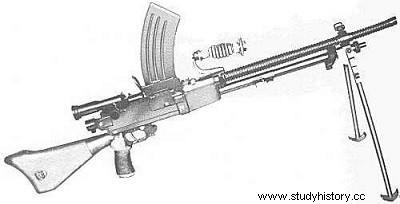
Type 11 and Type 96 submachine guns
In Japan, the heavy machine guns used between 1941 and 1945 were derivatives of the French Hotchkiss, with some detail modifications. The Japanese made their own F.M., but always inspired by the operating principle of the Hotchkiss. Their first F.M. was the Type 11, caliber 6.5 mm, put into service in 1922 and used until 1945. Its similarities with the Hotchkiss were obvious, especially with regard to the large-ribbed barrel, but a little less marked in the inner mechanism. This weapon had been designed by General Kijiro Nambu, and it was under the name of "Nambu" that it was known to the Allies. It was characterized above all by an original power supply system; it included a small hopper, placed on the left of the breech and making it possible to feed it with cartridges used by the other members of the infantry platoon. The cartridges could be introduced directly by barret-
tes of five, which made use of magazines or bands unnecessary. But this advantage was limited by the fragility of the mechanism, which often jammed because the rifle cartridges were too powerful.
The Japanese therefore had to use a cartridge with a reduced load, and employed an ammunition lubrication system which caused clogging of the mechanism.
The Type 11 had only 'automatic firing system and, during
firing, the feed hopper tended to unbalance the weapon, making it difficult to use. The Japanese built a special version with a fifty-round hopper, the Type 91, whose drawbacks were highlighted in the early thirties, during the fighting in China, so that a new model, the F.M. Type 96, was supplied to the troops.
Even if this new weapon included undeniable improvements compared to the previous model, it never completely replaced it, because the Japanese industry was never able to supply a single model in sufficient quantities for equip the whole army.
In its general operation, the Type 96 was a combination of the old Hotchkiss and some elements of the Czech ZB vz.26, which the Japanese had the opportunity to observe in China. In particular, they borrowed from the ZB vz.26 its magazine system, which replaced the Type 11 hopper, but retained the lubrication system, and therefore the risk of clogging. On the other hand, the Type 96 had a very fast barrel change system and several telescopic sights. The sights were quickly abandoned, but the magazine system maintained. The Type 96 finally had a unique accessory in the world on this type of weapon, a bayonet holder fixed to the end of the barrel. Its usefulness is questionable.
